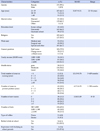Abstract
Purpose
Medical institutions and their patients benefit from continued employment of nurses. In this study an assessment was done of important factors that influence nurses' intention to leaving their jobs.
Methods
The sample consisted of 229 university hospital nurses. Data were analyzed using frequency, percentage, mean, standard deviation, t-test, ANOVA, Scheffé, Pearson's Correlation Analysis, and Hierarchical Multiple Regression.
Results
The control variables, including age, current position, and health status explained 18% (F=16.37, p<.001) of variance in retention intention. The control variables, bullying, job stress, self-esteem, and burnout collectively explained 27% of variance in retention intention.
Conclusion
The findings indicate that the factors influencing retention intention are age, current position, and health status, while self-esteem and burnout in work places are new and more recent factors that impact retention intention. These findings can be utilized to develop strategies to increase self-esteem and retention intention.
Figures and Tables
References
1. Jeong S, Kim JH. A critical review of nurse demand forecasting methods in empirical studies 1991~2014. Perspect Nurs Sci. 2016; 13(2):81–87.
2. Satoh M, Watanabe I, Asakura K. Occupational commitment and job satisfaction mediate effort-reward imbalance and the intention to continue nursing. Jpn J Nurs Sci. 2017; 14(1):49–60. DOI: 10.1111/jjns.12135.
3. Kim JK, Kim MJ. A review of research on hospital nurses' turnover intention. J Korean Acad Nurs Adm. 2011; 17(4):538–550. DOI: 10.11111/jkana.2011.17.4.538.
4. Cowin L. The effects of nurses' job satisfaction on retention: An Australian perspective. J Nurs Adm. 2002; 32(5):283–291.
5. Sung MH, Choi EY. The relationships between professional self- concept, nursing performance and retention intention of emergency department nurses. J Korean Acad Fundam Nurs. 2012; 19(2):244–252. DOI: 10.7739/jkafn.2012.19.2.244.
6. Lee EH, Cho KS, Son HM. A study of hospital nurse's intention to keep nursing job. J Korean Clin Nurs Res. 2014; 20(1):15–27.
7. Tourangeau AE, Cummings G, Cranley LA, Ferron EM, Harvey S. Determinants of hospital nurse intention to remain employed: broadening our understanding. J Adv Nurs. 2010; 66(1):22–32. DOI: 10.1111/j.1365-2648.2009.05190.x.
8. Wright C, McCartt P, Raines D, Oermann MH. Implementation and evaluation of self-scheduling in a hospital system. J Nurses Prof Dev. 2017; 33(1):19–24. DOI: 10.1097/nnd.0000000000000324.
9. Simons S. Workplace bullying experienced by massachusetts registered nurses and the relationship to intention to leave the organization. ANS Adv Nurs Sci. 2008; 31(2):E48–E59. DOI: 10.1097/01.ANS.0000319571.37373.d7.
10. Leymann H. The content and development of mobbing at work. Eur J Work Organ Psychol. 1996; 5(2):165–184. DOI: 10.1080/13594329608414853.
11. Quine L. Workplace bullying in nurses. J Health Psychol. 2001; 6(1):73–84. DOI: 10.1177/135910530100600106.
12. Hutchinson M, Wilkes L, Jackson D, Vickers MH. Integrating individual, work group and organizational factors: Testing a multidimensional model of bullying in the nursing workplace. J Nurs Manag. 2010; 18(2):173–181. DOI: 10.1111/j.1365-2834.2009.01035.x.
13. Laschinger HK, Grau AL, Finegan J, Wilk P. New graduate nurses' experiences of bullying and burnout in hospital settings. J Adv Nurs. 2010; 66(12):2732–2742. DOI: 10.1111/j.1365-2648.2010.05420.x.
14. Shin MH, Shin SR. Predictors of burnout among oncology nurses. J Korean Oncol Nurs. 2003; 3(1):75–84.
15. Rosenberg M. Society and the adolescent self-image. NJ: Princeton University Press Princeton;1965.
16. Kang YS, Choi YJ, Park DL, Kim IJ. A study on nurses' self-leadership, self-esteem, and organizational effectiveness. J Korean Acad Nurs Adm. 2010; 16(2):143–151. DOI: 10.11111/jkana.2010.16.2.143.
17. Einarsen S, Hoel H, Zapf D, Cooper CL. The concept of bullying and harassment at work: The European tradition. In : Einarsen S, Hoel H, Zapf D, Cooper CL, editors. Bullying and harassment in the workplace: Developments in Theory, Research, and Practice. 2nd ed. Boca Raton, FL: CRC Press;2011. p. 3–40.
18. Parker DF, DeCotiis TA. Organizational determinants of job stress. Organ Behav Hum Perform. 1983; 32(2):160–177. DOI: 10.1016/0030-5073(83)90145-9.
19. Jon BJ. Self-esteem: A test of its measurability. Yonsei Nonchong. 1974; 11(1):107–130.
20. Maslach C, Jackson SE. The measurement of experienced burnout. J Organ Behav. 1981; 2(2):99–113. DOI: 10.1002/job.4030020205.
21. Choi HY. Perfectionism tendency, social support and burnout among counselors [master's thesis]. Bucheon: The Catholic University of Korea;2002.
22. Han EH, Ha YM. Relationships among self-esteem, social support, nursing organizational culture, experience of workplace bullying, and consequence of workplace bullying in hospital nurses. J Korean Acad Nurs Adm. 2016; 22(3):303–312. DOI: 10.11111/jkana.2016.22.3.303.
23. Losa Iglesias ME, Vallejo RBDB. Prevalence of bullying at work and its association with self-esteem scores in a Spanish nurse sample. Contemp Nurse. 2012; 42(1):2–10. DOI: 10.5172/conu.2012.42.1.2.
24. Choi SO, Kim JH. Relationships among job stress, nursing performance, and retention intention of clinical nurses. J Korean Public Health Nurs. 2013; 27(1):142–152. DOI: 10.5932/jkphn.2013.27.1.142.
25. Kim CH, Yang SS, Kim YJ, Son YJ, You MA, Song JE. A structural equation model of nurses' turnover intention. J Korean Acad Nurs. 2009; 15(4):550–562.
26. Cavanaugh MA, Boswell WR, Roehling MV, Boudreau JW. An empirical examination of self-reported work stress among U.S. managers. J Appl Psychol. 2000; 85(1):65–74. DOI: 10.1037/0021-9010.85.1.65.
27. Karlson B, Jonsson P, Palsson B, Abjornsson G, Malmberg B, Larsson B, et al. Return to work after a workplace-oriented intervention for patients on sick-leave for burnout-a prospective controlled study. BMC Public Health. 2010; 10:301. DOI: 10.1186/1471-2458-10-301.
28. Chen MF, Ho CH, Lin CF, Chung MH, Chao WC, Chou HL, et al. Organisation-based self-esteem mediates the effects of social support and job satisfaction on intention to stay in nurses. J Nurs Manag. 2016; 24(1):88–96. DOI: 10.1111/jonm.12276.
29. Gumusluoglu L, Karakitapoğlu-Aygün Z, Hirst G. Transformational leadership and R&D workers' multiple commitments: Do justice and span of control matter? J Bus Res. 2013; 66(11):2269–2278. DOI: 10.1016/j.jbusres.2012.02.039.
30. Cassidy T, McLaughlin M, McDowell E. Bullying and health at work: The mediating roles of psychological capital and social support. Work Stress. 2014; 28(3):255–269. DOI: 10.1080/02678373.2014.927020.




 PDF
PDF ePub
ePub Citation
Citation Print
Print






 XML Download
XML Download